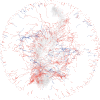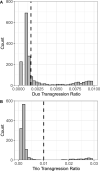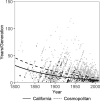Social network analysis of the genealogy of strawberry: retracing the wild roots of heirloom and modern cultivars
- PMID: 33772307
- PMCID: PMC8022721
- DOI: 10.1093/g3journal/jkab015
Social network analysis of the genealogy of strawberry: retracing the wild roots of heirloom and modern cultivars
Erratum in
-
Corrigendum to: "Social network analysis of the genealogy of strawberry: retracing the wild roots of heirloom and modern cultivars".G3 (Bethesda). 2021 Sep 27;11(10):jkab257. doi: 10.1093/g3journal/jkab257. G3 (Bethesda). 2021. PMID: 34568936 Free PMC article. No abstract available.
Abstract
The widely recounted story of the origin of cultivated strawberry (Fragaria × ananassa) oversimplifies the complex interspecific hybrid ancestry of the highly admixed populations from which heirloom and modern cultivars have emerged. To develop deeper insights into the three-century-long domestication history of strawberry, we reconstructed the genealogy as deeply as possible-pedigree records were assembled for 8,851 individuals, including 2,656 cultivars developed since 1775. The parents of individuals with unverified or missing pedigree records were accurately identified by applying an exclusion analysis to array-genotyped single-nucleotide polymorphisms. We identified 187 wild octoploid and 1,171 F. × ananassa founders in the genealogy, from the earliest hybrids to modern cultivars. The pedigree networks for cultivated strawberry are exceedingly complex labyrinths of ancestral interconnections formed by diverse hybrid ancestry, directional selection, migration, admixture, bottlenecks, overlapping generations, and recurrent hybridization with common ancestors that have unequally contributed allelic diversity to heirloom and modern cultivars. Fifteen to 333 ancestors were predicted to have transmitted 90% of the alleles found in country-, region-, and continent-specific populations. Using parent-offspring edges in the global pedigree network, we found that selection cycle lengths over the past 200 years of breeding have been extraordinarily long (16.0-16.9 years/generation), but decreased to a present-day range of 6.0-10.0 years/generation. Our analyses uncovered conspicuous differences in the ancestry and structure of North American and European populations, and shed light on forces that have shaped phenotypic diversity in F. × ananassa.
Keywords: DNA forensics; Fragaria; biodiversity; conservation genetics; domestication; kinship.
© The Author(s) 2021. Published by Oxford University Press on behalf of Genetics Society of America.
Figures









Similar articles
-
Genomic signatures of strawberry domestication and diversification.Plant Cell. 2024 May 1;36(5):1622-1636. doi: 10.1093/plcell/koad314. Plant Cell. 2024. PMID: 38113879 Free PMC article.
-
Unraveling the Complex Hybrid Ancestry and Domestication History of Cultivated Strawberry.Mol Biol Evol. 2021 May 19;38(6):2285-2305. doi: 10.1093/molbev/msab024. Mol Biol Evol. 2021. PMID: 33507311 Free PMC article.
-
Domestication of Temperate and Coastal Hybrids with Distinct Ancestral Gene Selection in Octoploid Strawberry.Plant Genome. 2018 Nov;11(3). doi: 10.3835/plantgenome2018.07.0049. Plant Genome. 2018. PMID: 30512037
-
[Genetic aspects of genealogy].Genetika. 2011 Nov;47(11):1451-72. Genetika. 2011. PMID: 22332404 Review. Russian.
-
Characterization of expansin genes and their transcriptional regulation by histone modifications in strawberry.Planta. 2021 Jul 3;254(2):21. doi: 10.1007/s00425-021-03665-6. Planta. 2021. PMID: 34216276 Review.
Cited by
-
Transgressive segregation, hopeful monsters, and phenotypic selection drove rapid genetic gains and breakthroughs in predictive breeding for quantitative resistance to Macrophomina in strawberry.Hortic Res. 2024 Jan 3;11(2):uhad289. doi: 10.1093/hr/uhad289. eCollection 2024 Feb. Hortic Res. 2024. PMID: 38487295 Free PMC article.
-
Exploration of a European-centered strawberry diversity panel provides markers and candidate genes for the control of fruit quality traits.Hortic Res. 2024 May 14;11(7):uhae137. doi: 10.1093/hr/uhae137. eCollection 2024 Jul. Hortic Res. 2024. PMID: 38988619 Free PMC article.
-
A Dominance Hypothesis Argument for Historical Genetic Gains and the Fixation of Heterosis in Octoploid Strawberry.Genetics. 2024 Oct 10;228(4):iyae159. doi: 10.1093/genetics/iyae159. Online ahead of print. Genetics. 2024. PMID: 39385702 Free PMC article.
-
Genomic signatures of strawberry domestication and diversification.Plant Cell. 2024 May 1;36(5):1622-1636. doi: 10.1093/plcell/koad314. Plant Cell. 2024. PMID: 38113879 Free PMC article.
-
A multi-omics framework reveals strawberry flavor genes and their regulatory elements.New Phytol. 2022 Nov;236(3):1089-1107. doi: 10.1111/nph.18416. Epub 2022 Aug 20. New Phytol. 2022. PMID: 35916073 Free PMC article.
References
-
- Affymetrix Inc. 2015. Axiom® Genotyping Solution Data Analysis Guide (P/N 702961 Rev. 3). Santa Clara, CA: Affymetrix, Inc..
-
- Ahmadi H, Bringhurst RS, Voth V.. 1990. Modes of inheritance of photoperiodism in Fragaria. J Am Soc Hortic Sci. 115:146–152.
-
- Barabási A-L. 2016. Network Science. Cambridge, UK: Cambridge University Press.
Publication types
MeSH terms
Associated data
LinkOut - more resources
Full Text Sources
Other Literature Sources
Miscellaneous
